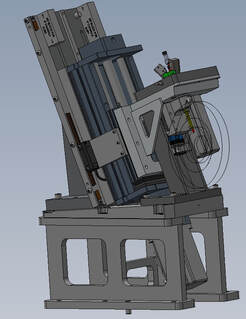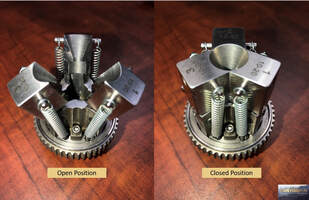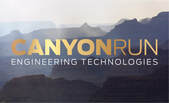Bone Marrow Biopsy Needles | Electrochemical Grind (ECG) Tooling |
The Challenge
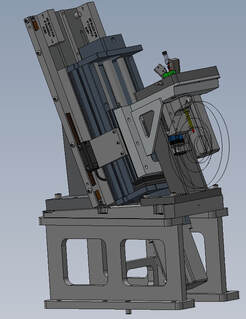 Fixture built for ECG of biopsy needles
Fixture built for ECG of biopsy needles
A medical technology company specializing in hypodermic needles and catheter equipment was having quality issues with the beveling process of their bone marrow biopsy needles. Using conventional grinding, significant burrs would form and occasionally leave dark burn marks along the needle tip. The customer requested Canyon Run Engineering Technologies to develop a solution to reduce these growing issues affecting their biopsy needle product line while also providing tooling capable of fabricating the unique tips of the biopsy needles.
Why Choose Canyon Run?
Canyon Run Engineering Technologies was able to offer our engineering services and expertise built by an extensive history designing for medical devices and novel processes. Working closely with the customer’s project team, automated tooling paired with a new process, suggested by our team, eliminated their original challenges while also providing the added benefit of removing an existing secondary operation.
Our Solutions
Canyon Run brought in the low-contact Electrochemical Grinding (ECG) technology. Using the same principles as Electrochemical Machining (ECM), popular with high precision manufactures, ECG uses an electrolytic process with a grinding wheel to achieve an ultrafine burr-free bevel on biopsy needles. This improves the as-ground edge and sharpness to the required quality that previously required secondary electropolish operations. Burn marks are also nonexistent as the low contact characteristics of this process lead to reduced heat input.
Because of the high salinity environment required for the electrolytic process, corrosion and wear of the mechanical tooling components are typical concerns. To reduce these harmful effects and promote the electrolytic reactions, specialized techniques by Canyon Run and non-standard materials were used when designing the compatible fixturing. Along with the complex considerations in designing for ECG, synchronized linear and rotational axis were incorporated into the tooling to bevel the array of trocar-style needle points, used as cutting teeth during core sampling. By introducing servo drives into our design, requiring a simple program change for part setup, the customer-proposed cammed tooling was no longer necessary. This reduced design and manufacturing costs of multiple cam systems while also removing any expenses from the time changing out multiple fixtures for the different part types.
Why Choose Canyon Run?
Canyon Run Engineering Technologies was able to offer our engineering services and expertise built by an extensive history designing for medical devices and novel processes. Working closely with the customer’s project team, automated tooling paired with a new process, suggested by our team, eliminated their original challenges while also providing the added benefit of removing an existing secondary operation.
Our Solutions
Canyon Run brought in the low-contact Electrochemical Grinding (ECG) technology. Using the same principles as Electrochemical Machining (ECM), popular with high precision manufactures, ECG uses an electrolytic process with a grinding wheel to achieve an ultrafine burr-free bevel on biopsy needles. This improves the as-ground edge and sharpness to the required quality that previously required secondary electropolish operations. Burn marks are also nonexistent as the low contact characteristics of this process lead to reduced heat input.
Because of the high salinity environment required for the electrolytic process, corrosion and wear of the mechanical tooling components are typical concerns. To reduce these harmful effects and promote the electrolytic reactions, specialized techniques by Canyon Run and non-standard materials were used when designing the compatible fixturing. Along with the complex considerations in designing for ECG, synchronized linear and rotational axis were incorporated into the tooling to bevel the array of trocar-style needle points, used as cutting teeth during core sampling. By introducing servo drives into our design, requiring a simple program change for part setup, the customer-proposed cammed tooling was no longer necessary. This reduced design and manufacturing costs of multiple cam systems while also removing any expenses from the time changing out multiple fixtures for the different part types.
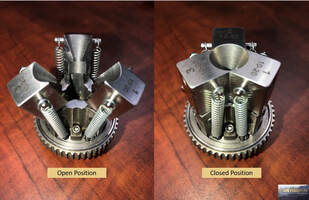 Three position over-center clamp
Three position over-center clamp
To aid a three jaw robot in loading biopsy needles, Canyon Run designed a three position over-center clamp that improved the cycle time in the new ECG system. The robot first loads the needle into the clamp's closed first position. Upon opening the three jaws, the closed first position clamp guides the needle into the top of the fixture. The jaws continue to expand, pushing the clamp into the open second position and allowing the needle to fall further into the fixture and come to rest in an electrically conductive bushing. After closing the three jaws, the robot presses the needle into its fully seated final position which simultaneously closes the clamp, securing the needle for the grinding process.
The Results
By opting for the Canyon Run engineering design, a robust fixture compatible with the ECG process was accepted and successfully implemented by the customer, leading to the removal of burrs and burn spots. Switching to ECG from conventional grinding also had the added benefit of reducing the total needle manufacturing cost by the removal of the secondary electropolish operation. To date, this system has sharpened several hundred thousand bone marrow biopsy needles.
Key Features: Canyon Run Engineering Technologies was approached to develop a solution to reduce burrs and burn marks on biopsy needles formed during conventional grinding. Electrochemical Grinding (ECG) was chosen as a suitable solution with the added benefit of eliminating a secondary electropolish operation. Synchronized programmable servo drives removed the necessity of multiple cam fixtures to cover the entire needle product line. A three position over-center clamp was designed to aid robotic loading while electrically isolating mechanical tooling components while enhancing needle tip conductivity.
The Results
By opting for the Canyon Run engineering design, a robust fixture compatible with the ECG process was accepted and successfully implemented by the customer, leading to the removal of burrs and burn spots. Switching to ECG from conventional grinding also had the added benefit of reducing the total needle manufacturing cost by the removal of the secondary electropolish operation. To date, this system has sharpened several hundred thousand bone marrow biopsy needles.
Key Features: Canyon Run Engineering Technologies was approached to develop a solution to reduce burrs and burn marks on biopsy needles formed during conventional grinding. Electrochemical Grinding (ECG) was chosen as a suitable solution with the added benefit of eliminating a secondary electropolish operation. Synchronized programmable servo drives removed the necessity of multiple cam fixtures to cover the entire needle product line. A three position over-center clamp was designed to aid robotic loading while electrically isolating mechanical tooling components while enhancing needle tip conductivity.
The Challenge
A medical technology company specializing in hypodermic needles and catheter equipment was having quality issues with the beveling process of their bone marrow biopsy needles. Using conventional grinding, significant burrs would form and occasionally leave dark burn marks along the needle tip. The customer requested Canyon Run Engineering Technologies to develop a solution to reduce these growing issues affecting their biopsy needle product line while also providing tooling capable of fabricating the unique tips of the biopsy needles.
Why Choose Canyon Run?
Canyon Run Engineering Technologies was able to offer our engineering services and expertise built by an extensive history designing for medical devices and novel processes. Working closely with the customer’s project team, automated tooling paired with a new process, suggested by our team, eliminated their original challenges while also providing the added benefit of removing an existing secondary operation.
Our Solutions
Canyon Run brought in the low-contact Electrochemical Grinding (ECG) technology. Using the same principles as Electrochemical Machining (ECM), popular with high precision manufactures, ECG uses an electrolytic process with a grinding wheel to achieve an ultrafine burr-free bevel on biopsy needles. This improves the as-ground edge and sharpness to the required quality that previously required secondary electropolish operations. Burn marks are also nonexistent as the low contact characteristics of this process lead to reduced heat input.
Because of the high salinity environment required for the electrolytic process, corrosion and wear of the mechanical tooling components are typical concerns. To reduce these harmful effects and promote the electrolytic reactions, specialized techniques by Canyon Run and non-standard materials were used when designing the compatible fixturing.
Why Choose Canyon Run?
Canyon Run Engineering Technologies was able to offer our engineering services and expertise built by an extensive history designing for medical devices and novel processes. Working closely with the customer’s project team, automated tooling paired with a new process, suggested by our team, eliminated their original challenges while also providing the added benefit of removing an existing secondary operation.
Our Solutions
Canyon Run brought in the low-contact Electrochemical Grinding (ECG) technology. Using the same principles as Electrochemical Machining (ECM), popular with high precision manufactures, ECG uses an electrolytic process with a grinding wheel to achieve an ultrafine burr-free bevel on biopsy needles. This improves the as-ground edge and sharpness to the required quality that previously required secondary electropolish operations. Burn marks are also nonexistent as the low contact characteristics of this process lead to reduced heat input.
Because of the high salinity environment required for the electrolytic process, corrosion and wear of the mechanical tooling components are typical concerns. To reduce these harmful effects and promote the electrolytic reactions, specialized techniques by Canyon Run and non-standard materials were used when designing the compatible fixturing.
Along with the complex considerations in designing for ECG, synchronized linear and rotational axis were incorporated into the tooling to bevel the array of trocar-style needle points, used as cutting teeth during core sampling. By introducing servo drives into our design, requiring a simple program change for part setup, the customer-proposed cammed tooling was no longer necessary. This reduced design and manufacturing costs of multiple cam systems while also removing any expenses from the time changing out multiple fixtures for the different part types.
To aid a three jaw robot in loading biopsy needles, Canyon Run designed a three position over-center clamp that improved the cycle time in the new ECG system. The robot first loads the needle into the clamp's closed first position. Upon opening the three jaws, the closed first position clamp guides the needle into the top of the fixture. The jaws continue to expand, pushing the clamp into the open second position and allowing the needle to fall further into the fixture and come to rest in an electrically conductive bushing. After closing the three jaws, the robot presses the needle into its fully seated final position which simultaneously closes the clamp, securing the needle for the grinding process.
To aid a three jaw robot in loading biopsy needles, Canyon Run designed a three position over-center clamp that improved the cycle time in the new ECG system. The robot first loads the needle into the clamp's closed first position. Upon opening the three jaws, the closed first position clamp guides the needle into the top of the fixture. The jaws continue to expand, pushing the clamp into the open second position and allowing the needle to fall further into the fixture and come to rest in an electrically conductive bushing. After closing the three jaws, the robot presses the needle into its fully seated final position which simultaneously closes the clamp, securing the needle for the grinding process.
The Results
By opting for the Canyon Run engineering design, a robust fixture compatible with the ECG process was accepted and successfully implemented by the customer, leading to the removal of burrs and burn spots. Switching to ECG from conventional grinding also had the added benefit of reducing the total needle manufacturing cost by the removal of the secondary electropolish operation. To date, this system has sharpened several hundred thousand bone marrow biopsy needles.
Key Features: Canyon Run Engineering Technologies was approached to develop a solution to reduce burrs and burn marks on biopsy needles formed during conventional grinding. Electrochemical Grinding (ECG) was chosen as a suitable solution with the added benefit of eliminating a secondary electropolish operation. Synchronized programmable servo drives removed the necessity of multiple cam fixtures to cover the entire needle product line. A three position over-center clamp was designed to aid robotic loading while electrically isolating mechanical tooling components while enhancing needle tip conductivity.
By opting for the Canyon Run engineering design, a robust fixture compatible with the ECG process was accepted and successfully implemented by the customer, leading to the removal of burrs and burn spots. Switching to ECG from conventional grinding also had the added benefit of reducing the total needle manufacturing cost by the removal of the secondary electropolish operation. To date, this system has sharpened several hundred thousand bone marrow biopsy needles.
Key Features: Canyon Run Engineering Technologies was approached to develop a solution to reduce burrs and burn marks on biopsy needles formed during conventional grinding. Electrochemical Grinding (ECG) was chosen as a suitable solution with the added benefit of eliminating a secondary electropolish operation. Synchronized programmable servo drives removed the necessity of multiple cam fixtures to cover the entire needle product line. A three position over-center clamp was designed to aid robotic loading while electrically isolating mechanical tooling components while enhancing needle tip conductivity.
